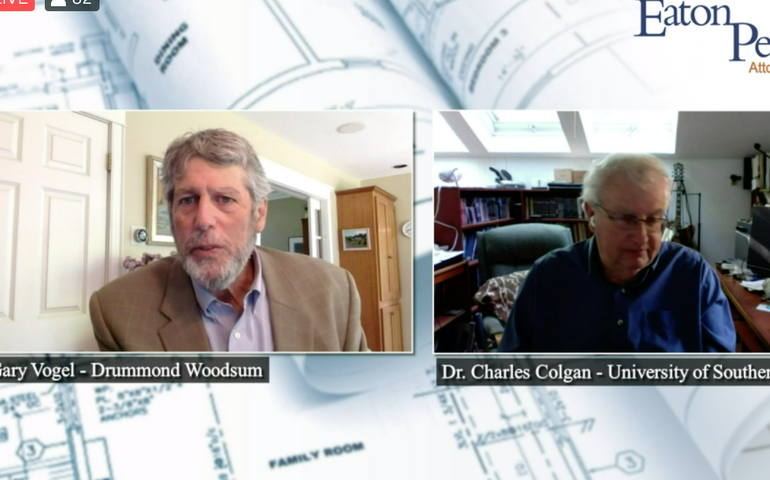The latest compilation of Maine real estate data showed that 2019 was a good year.
“The real estate industry through 2019 was doing pretty much okay and had generally been on the upswing, particularly in the second half of the year,” said Charles Colgan, an economist who tracks the health of Maine’s real estate market.
Then came the pandemic.
“I don’t know that we’ll be able to avoid a lost first half of the decade in the economy as a whole,” he added.
Colgan spoke during the Maine Real Estate & Development Association’s (MEREDA) presentation of its annual index at a webinar Thursday morning. Colgan is a senior research advisor and professor emeritus of public policy and management at the Muskie School of Public Service at the University of Southern Maine.
MEREDA hired Colgan to analyze the health of Maine’s real estate activity according to the residential, commercial, and construction sectors of the real estate industry.
Using nine seasonally-adjusted measures, Colgan produces a single composite number: the MEREDA Index, which benchmarks the year for posterity, as well as for use by professionals and policymakers.
Colgan established 2006 as the benchmark year for the index, ascribing that year with a composite number of 100.
Years above 100 indicate the market is trending upward. In 2019, the index was 105.91, which was 2.2% above 2018.
Broken out by sectors:
- Residential index: 103.9. The residential market showed solid growth through 2019. Residential permits were up 16.7%, mortgage origination up 7.5%, units-sold up 1.7% and median home price up 3.5%. However, building permits fell the second half of 2019.
- Commercial index: 109.7. The commercial market grew across all sectors. The downtown Portland class A office market, with nearly 2.2 million square feet of space, finished 2019 with an all-time low vacancy rate of 0.4%. Likewise, the industrial sector had a historically low 1.84% direct vacancy rate. Tenants and buyers in the office and industrial markets had a difficult time finding available product, which triggered several construction projects.
- Construction employment index: 95. This was up 2.8% over 2018 but didn’t reach 2006 levels. Growth was steady though 2019 except for a slight dip in the second quarter.
Check-shaped recovery
But the pandemic and resulting economic meltdown pose new questions for the market.
Maine saw a loss of 100,000 jobs in one month. Colgan said he expects that new state numbers, expected to come out in the next couple of weeks, will likely show an additional 10,00 to 20,000 jobs lost. The drop in employment goes far lower than the recession of 2008-09.
“It paints a picture of how long it will take us to get out of this,” Colgan said. “How long that will be is the big question of the day. So much of the recovery doesn’t depend on economic factors, per se, but on how fast the public health system and the medical system can respond to the health emergency.”
While there’s been discussion about whether there will be a “V-shaped recovery” or a “W-shaped recovery,” Colgan expects a “left-handed check recovery.”
“That means there will be some bounce back probably in the third quarter, maybe in the fourth,” he said. “But it will be far short of the drop. And it will be from that relatively modest bounce back that the long-term recovery will take place. The long-term question is how long will it take to get back.”
Retail as indicator
Colgan said certain factors that have been intensified by the pandemic will likely impact the real estate market into the future.
That includes retail. In the 1990-92 recession, retail was a leading indicator of recovery, he said.
Beginning with the 2001 recession and then the recession of 2008-09, that was no longer true.
“In the last decade, retail has trended down throughout the U.S. in terms of employment,” he said. “That has now dramatically accelerated. And because it was already on a downward-sloping trend, the possibility that retail will come roaring back just doesn’t seem very likely because there were underlying factors in the retail sector that were already pushing downward. We now have pushed a lot of retail off the cliff.”
That doesn’t mean all retail jobs are gone and that Amazon will take over the world, he said.
“But it means the retail jobs and the physical space in order to have those jobs will likely be much less than the decades before,” he continued.
Spatial reorganization
In addition, he said, the trend of working remotely is likely to accelerate — a trend starkly illustrated by pandemic.
“We reorganized the spatial economy in two weeks this year,” Colgan said. “It’s an astonishing change. How much of that is going to apply out into the future. I don’t know. But I do know that one of the surest thing that will happen is some major reorganization of the spatial arrangement in the economy.”
A related question, he said, is whether in-migration to Maine, at least partly driven by people seeking to leave pandemic hotspots, will start to fill suburban housing stock that was sold by baby boomers who have moved Maine’s revitalized downtowns.
Colgan said he views economic recovery from the pandemic as a three-phase process. The current phase is the shock still underway of massive numbers of jobs lost and economic suffering.
The second phase is rolling in with the summer months; the question is how much of the summer tourist economy can take place.
“Looking beyond that, the question is going to be largely the structure and nature of whatever fiscal help is coming from Washington, if any does indeed come,” he said.
